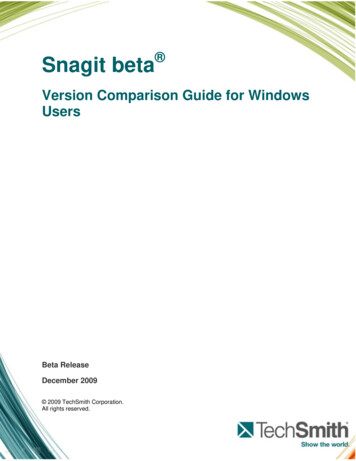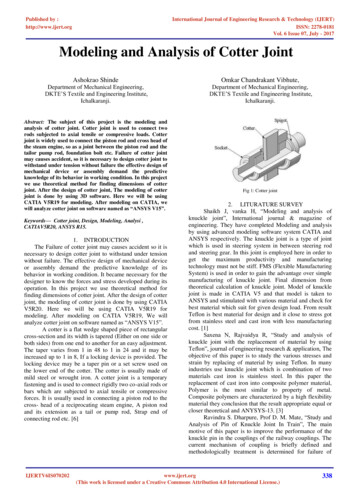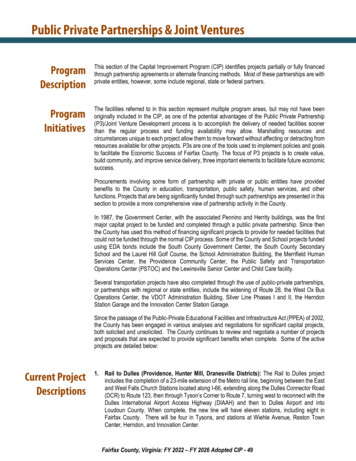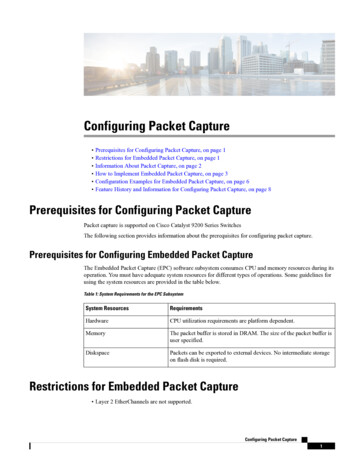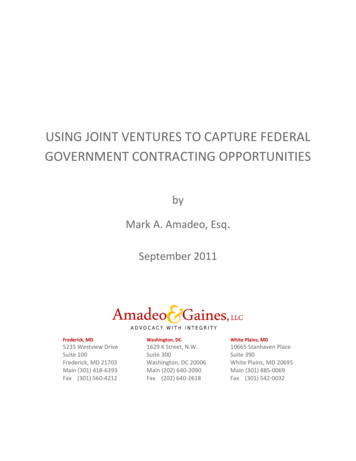
Transcription
USING JOINT VENTURES TO CAPTURE FEDERALGOVERNMENT CONTRACTING OPPORTUNITIESbyMark A. Amadeo, Esq.September 2011Frederick, MDWashington, DCWhite Plains, MD5235 Westview DriveSuite 100Frederick, MD 21703Main (301) 418-6393Fax (301) 560-42121629 K Street, N.W.Suite 300Washington, DC 20006Main (202) 640-2090Fax (202) 640-261810665 Stanhaven PlaceSuite 390White Plains, MD 20695Main (301) 885-0069Fax (301) 542-0032
Table of ContentsINTRODUCTION .1I.TEAMING ARRANGEMENTS.2II.ADVANTAGES OF JOINT VENTURES .2A.JOINT VENTURES MAY COMPETE FOR SMALL BUSINESSES CONTRACTS .31.General Rule on Affiliation of Joint Venture Partners .42.Three Exceptions to Rule on Affiliation .43.Additional Conditions When Joint Ventures Are Awarded 8(a) Contracts .54.Limitations on Contracts Awarded To Joint Ventures .7B.JOINT VENTURES MAY COMPETE AS SMALL DISADVANTAGED BUSINESSES .7C.JOINT VENTURES MAY COMPETE FOR HUBZone CONTRACTS .8D.JOINT VENTURES MAY COMPETE FOR SDVOSB CONTRACTS .8E.JOINT VENTURES MAY COMPETE FOR WOSB & EDWOSB CONTRACTS .8III.OTHER CONSIDERATIONS .9
INTRODUCTIONIn 2007, the U.S. Department of Defense declared “due in part to shrinking budgets andacquisition resources – contract consolidation is a trend that is likely to continue.”1 There canbe little dispute that DOD’s prediction has played itself out and that contracts throughout thefederal marketplace increasingly have been consolidated and become larger. The U.S.Department of Homeland Security’s (DHS) 9 billion information technology support servicescontract - Enterprise Acquisition Gateway for Leading Edge Solutions (EAGLE I) – marketed as amultiple award, indefinite-delivery, indefinite-quantity (IDIQ) contract exemplifies an emergingtrend. Although 544 task orders were awarded under the EAGLE I contract between 2006 and2011, at least three of the task orders nearly topped 1 billion, while at least sixteen moreexceeded 100 million each. Subsequently, in July 2010, DHS followed up the Eagle I contractwith its solicitation for the mammoth 22 billion EAGLE II IDIQ contract.2Congressional debate during the Summer of 2011 and ensuing federal legislation tocurtail growing federal budget deficits will only increase pressure on federal governmentagencies to do the same or more “with less.” Therefore, contract consolidation will likelycontinue to accelerate and contracts will become larger and more complex, while opportunitiesfor small businesses to single-handedly complete contract tasks or meet all contractrequirements will diminish.As the U.S. Department of Defense acknowledged, again back in 2007, the growth in sizeand complexity of government contracts has made teaming “a necessity” in the federalmarketplace. Recent changes to regulations by the U.S. Small Business Administration on jointventures reflect this new reality: small businesses must aggressively establish teaming partnersto stay competitive.This paper discusses the rules on joint ventures that enable businesses to form strategicteaming relationships to secure federal government contracts.1
I.TEAMING ARRANGEMENTSThe Federal Acquisition Regulations (“FAR”), the rulebook federal government agenciesmust follow when they contract for goods and services, explicitly acknowledges and implicitlyencourages teaming arrangements:The government will recognize the integrity and validity of contractor teamarrangements provided, the arrangements are identified and companyrelationships are fully disclosed in an offer or, for arrangements entered intoafter their submission of an offer, before the arrangement becomes effective.The government will not normally require or encourage the dissolution ofcontractor team arrangement.3Indeed, FAR states that team arrangements may be desirable from both governmentand industry standpoint in order to enable the companies to (1) complement each other'sunique capabilities, and (2) offer the government the best combination of performance, cost,and delivery for the system or product being acquired. Further, FAR acknowledges that teamarrangements may be particularly appropriate in complex research and developmentprocurements.4The federal contracting rules recognize two kinds of “contractor team arrangements.”5The first kind of team arrangement occurs when companies align horizontally, either aspartnerships or joint ventures, to act as the prime contractor. 6 The second kind of teamarrangement occurs when companies align vertically to divide work along a prime contractorsubcontractor chain.II.ADVANTAGES OF JOINT VENTURESThe federal acquisition rules have a very specific notion of what constitutes a “jointventure” for teaming purposes. Specifically, a joint venture is defined as a business associationthat is intended to last for a limited duration and for specific purpose:A joint venture for size determination purposes is an association of persons orconcerns with interests in any degree or proportion by way of contract, expressor implied, consorting to engage in and carry out a single specific businessventure for joint profit, for which purpose they combine their efforts, property,money, skill, or knowledge, but not on a continuing or permanent basis forconducting business generally.7Teaming arrangements, whether they are joint ventures or prime-subcontractorarrangements, offer tangible benefits to government contractors. They enable companies tocollectively fulfill contract requirements that they could not fulfill separately. In addition,2
government agencies routinely factor a bidder’s “past performance” on the same or similargovernment contracts, in their evaluation of a proposal, and teaming arrangements enableparties to overcome past performance gaps of a particular business.Although the most prevalent teaming arrangement in federal government contracting isthe prime-subcontractor arrangement, joint ventures enable contractors to achieve additionalgovernment contracting objectives. Joint venture arrangements: Enable companies to spread risks of prime-contractingPermit companies to leverage their combined capitalAllow all parties to have a voice and control over how the contract is performedand managedEnable parties to share in profits of the entire projectEnable parties to develop direct relationships with the government agencycontracting officialsEnable small businesses to offer bonding capacity of larger companiesTypically, only a prime contractor has privity of contract. That is, the prime contractor –and not any of the subcontractors – is a party to the contract with the government agency andonly the prime contractor has an enforceable right against the government for the benefitsunder the government contract. A subcontractor, in turn, typically only has privity of contractunder a subcontracting agreement with the prime contractor. Therefore, when a subcontractorhas a dispute with a prime contractor over payment for services, the subcontractor usuallycannot seek payment directly from the federal government. Joint venture arrangements,however, enable all teaming partners to have “privity” of contract with the contractinggovernment agency.In addition, as described further below, federal regulations enable joint venturepartners to bid for contracts that collectively or separately they might not otherwise be eligibleto compete for.A. JOINT VENTURES MAY COMPETE FOR SMALL BUSINESSES CONTRACTSGovernment contracting officers routinely establish small business requirements, andsize standards for what constitutes a small business, for the government contracts they solicit.These small business size standards are specific for each industry (typically as set forth in theNorth American Industry Classification System or “NAICS”) and establish ceilings on revenueand number employees for a business to be considered a “small business” for purposes of theprocurement. Under certain circumstances, joint venture partners may enjoy all the benefitsof the joint venture arrangement, and still compete for contracts that are “set aside” for smallbusinesses or that have small business participation requirements, even though the combinedsize of the joint venture parties exceeds the small business size standard set by a governmentagency.3
In fact, changes in February 2011 to regulations issued by the U.S. Small BusinessAdministration (SBA), which is charged with regulating and enforcing the rules on smallbusiness participation in federal government contracting, have increased opportunities for jointventures that may collectively exceed the small business size standards for governmentcontracts.1. General Rule on Affiliation of Joint Venture PartnersIt should be noted that as a general rule, joint venture partners are deemed to be“affiliated” for purposes of small business size standards that may be set for a federalgovernment contract.8 That is, as affiliates, the revenues and number of employees of the jointventure partners are required to be combined in order to determine if the joint venture shouldbe considered a “small business” for purposes of any small business participation requirementsof a federal contract.92. Three Exceptions to Rule on AffiliationThere are three exceptions, however, to the requirement that joint ventures should bedeemed affiliated and their revenues and number of employees combined. Importantly, the2011 changes to the SBA regulations expressly allow a joint venture to be excluded fromaffiliation requirements under these exceptions whether or not the joint venture is formed as aseparate legal entity (e.g. an LLC), and whether or not any separate legal entity is populated(e.g., has its own employees).10a. Small Business Joint VenturesOne exception applies when each partner qualifies separately as a small business under thesize standard that is set for the government contract.11 Under this exception, the contract musteither qualify as a “bundled” contract, or the contract dollar value must be greater than 10million (if the size standard is based on the number of employees) or greater than half the sizestandard (if the size standard is based on revenue).12 A “bundled” contract occurs when twoor more requirements that were previously provided under separate smaller contracts arecombined into a single contract that is “likely to be unsuitable for award to a small businessconcern” due to (1) the diversity, size or specialized nature of the elements of the workrequired, (2) the aggregate dollar value of the anticipated award, (3) the geographicaldispersion of the contract performance sites; or (4) a combination of these factors. 13This exception to affiliation enables small businesses to compete collectively for contractsset aside for a small business that they would otherwise not be able to perform on their ownseparately because of the size or complexity of the contract.4
b. 8(a) Joint VenturesAnother exception to the general affiliation rule applies to joint ventures that competefor a contract that is set aside for businesses that participate in the SBA’s 8(a) BusinessDevelopment Program (8(a) BD Program). The 8(a) BD Program provides business developmentservices for small businesses that are owned and controlled at least 51% by socially andeconomically disadvantaged individuals.Under the exception for 8(a) Joint Ventures, all of the members of the joint venturemust each satisfy the small business size standard for the contract, with at least one businessbeing a participant in the 8(a) BD Program. In addition, the size of at least one of the 8(a)businesses must be less than half of the small business size standard set for the contract. Also,the dollar amount of the government contract must exceed either half the size standard (if thesize standard is based on revenue) or 10 million (if the size standard is based on number ofemployees). An important aspect of this exception is that it enables small businesses that donot participate in the 8(a) BD Program to nevertheless compete for 8(a) set aside contracts.c. Mentor – Protégé Joint VenturesAnother exception to affiliation applies to joint ventures that consist of companiesapproved by the SBA to be mentors and protégé’s under the SBA’s Mentor Protégé Program.The SBA’s Mentor-Protégé Program, offered under the 8(a) BD Program, enables 8(a)participants to obtain technical and management assistance, certain financial assistance, andprime contracting opportunities from approved “mentors,” which themselves do not have to besmall businesses or owned by socially or economically disadvantaged individuals.For the Mentor-Protégé Joint Venture exception to apply, the 8(a) participant/protégémust qualify as a small business under the small business size standard set for theprocurement, and the contract awarded must not exceed the limit on sole source 8(a) awards.The mentor, on the other hand, can be a large business. Thus, the Mentor-Protégé JointVenture exception presents a particularly rare opportunity for a large business to compete for afederal government contract that is set aside for small businesses.Another important aspect of Mentor-Protégé Joint Venture exception to affiliation, asamended by the SBA regulation, is that it now also applies when the joint venture performs as asubcontractor, and not just as a prime contractor.3. Additional Conditions When Joint Ventures Are Awarded 8(a) ContractsThe amended SBA regulations impose additional requirements when a joint venture isawarded an 8(a) set-aside contract (either as a Mentor-Protégé Joint Venture or an 8(a) JointVenture).5
a. Joint Venture Agreements Must Meet Certain RequirementsA joint venture agreement to perform an 8(a) set aside contract must set forth thepurpose of the joint venture and must be approved by the SBA before the contract is awarded.If the joint venture is a separate legal entity, the joint venture agreement must also state thatthe 8(a) partner owns at least 51% of the joint venture and that the 8(a) partner will receiveprofits commensurate with its ownership interest in the joint venture. If the joint venture isnot a separate legal entity, the joint venture agreement must state that the 8(a) participant willreceive profits commensurate with the work performed by the 8(a) partner. The joint ventureagreement must also indicate that the 8(a) participant controls the accounting andadministrative records, and retains final original records upon completion of the contract.For an unpopulated joint venture or joint venture populated only with administrativepersonnel, a joint venture agreement also must designate an employee of the 8(a) managingpartner as the project manager responsible for performance of the contract. For a jointventure populated with individuals intended to perform the contract, the joint venture mustdemonstrate that performance of the contract is controlled by the 8(a) managing partner.b. The Joint Venture Must Meet Work Sharing RequirementsFor unpopulated joint ventures or joint ventures populated only with administrativepersonnel, the 8(a) partner(s) must perform at least 40% of the work, and the work must bemore than administrative or ministerial. For populated joint ventures, each 8(a) partner mustdemonstrate what it will gain from performance and how the performance will assist in itsbusiness development.14c. The Joint Venture Must Meet Subcontracting ConditionsIn a populated joint venture, a non-8(a) partner and its affiliates may not act assubcontractors to the joint venture or to any subcontractors. Consequently, if the non-8(a)partner wishes to do more work under the contract, the work must be done through the jointventure, which may require additional work to be assigned to the 8(a) partner so that the 8(a)partner can still meet the 40% work share requirement. In an unpopulated joint venture orventure populated only with administrative personnel, the joint venture may subcontract workto the non-8(a) partner as long as it also subcontracts work to the 8(a) partner to meet the 40%work share requirement.15As a consequence of the additional requirements, teaming partners that wish to workunder 8(a) contracts will have to carefully plan in advance how they wish to structure the jointventure because those decisions will necessarily impact how work is shared and profitsallocated. As stated, if the joint venture is a separate legal entity, the 8(a) partner must receiveprofits commensurate with its ownership interest (at least 51%), but if the joint venture is not aseparate legal entity, the 8(a) participant must receive profits commensurate with its share ofwork (at least 40%).6
4. Limitations on Contracts Awarded To Joint VenturesAnother important change to the affiliation rules as a result of 2011 changes to the SBAregulations has increased the number of bids that joint ventures can submit. Before the 2011changes, joint ventures were limited to submitting three contract offers over a two-year period.Small businesses with combined sizes that exceeded size standards that wished to takeadvantage of one of the three affiliation exceptions, therefore, were forced to pick and choosecarefully the small business contracts they believed they could successfully bid for as a jointventure. The 2011 SBA amendments to the regulations liberalized the definition of jointventure for purposes of the affiliation rules by eliminating the restriction on number of bids ajoint venture can submit. Instead, the SBA regulation effectively limits the number of contractsthat a joint venture can be awarded to three over a two-year period:A joint venture is an association of individuals and/or concerns with interests inany degree or proportion by way of contract, express or implied, consorting toengage in and carry out no more than three specific or limited-purpose businessventures for joint profit over a two year period, for which purpose they combinetheir efforts, property, money, skill, or knowledge, but not on a continuing orpermanent basis for conducting business generally.16The amended SBA regulation make clear that the time for counting the three awards isas of the date the joint venture submits its proposal. Consequently, a joint venture with twocontract awards can submit two bids for contracts, both of which can be awarded to the jointventure, since at the time the bids for each contract were offered, the joint venture only hadtwo contract awards. In addition, the amended SBA regulation allows the same parties to ajoint venture that has been awarded three contracts to form a second (and then third . . . )additional joint venture, which in turn is potentially eligible to perform under three newcontracts. The regulations, however, acknowledge that at some point a long-lastingrelationship will lead to a finding that the joint venture partners are affiliated.17B. JOINT VENTURES MAY COMPETE AS SMALL DISADVANTAGED BUSINESSESUnder certain conditions, a joint venture may able to enjoy benefits typically enjoyed bybusinesses certified as small disadvantaged businesses (SDB’s) by the SBA, such as priceevaluations, evaluation factors and subfactors, and monetary subcontracting incentives. Toqualify as an SDB business for these purposes, at least one of the joint venture partners mustbe SDB-certified by the SBA or must have submitted an application for certification and notreceived a negative determination. In addition, the SDB partner must be the manager of thejoint venture and the employee of the SDB must be the project manager responsible forcontract performance. Lastly, the joint venture must perform any work required of SDBofferors and the SDB partner must perform a significant portion of the contract.187
However, unless the joint venture satisfies one of the three exceptions to affiliation thatapplies for small business contracts (described in part II.A.2, above – i.e., it is a Small BusinessJoint Venture, Mentor-Protégé Joint Venture, or 8(a) Joint Venture) the parties to the jointventure will be deemed affiliated and their revenues and employee numbers will be combinedfor purposes of the size standards set for the contract.C. JOINT VENTURES MAY COMPETE FOR HUBZone CONTRACTSA joint venture that comprises solely of businesses that participate in the SBA’sHistorically Underutilized Business Zones (HUBZone) program may compete for a contract setaside for a HUBZone business, as long as each joint-venture partner is small under the sizestandard for the contract. In addition, the HUBZone businesses collectively may exceed the sizestandard for the contract and still compete for the contract as long as the dollar amount of thecontract exceeds either half the size standard (if the size standard is based on revenue), or 10million (if the size standard is based on number of employees). If the contract does not exceedthese amounts, the HUBZone joint venture may compete for the HUBZone contract only as longas the combined size of the joint venture does not exceed the size standard for the contract. 19D. JOINT VENTURES MAY COMPETE FOR SDVOSB CONTRACTSJoint ventures may also compete for contracts set aside for businesses that participatein the SBA’s Service-Disabled Veteran-Owned Small Business Concern Program. The jointventure must include at least one service-disabled veteran-owned small business concern(SDVOSB) and all joint venture partners must qualify as a small business under the sizestandards for the contract. In addition, the dollar amount of the contract must exceed eitherhalf the size standard (if the size standard is based on revenue) or 10 million (if the sizestandard is based on number of employees). If a sole source contract or competitiveprocurement does not exceed these contract sizes, the SDVOSB joint venture will only qualify asa small business if the combined revenue or number of employees meets the size standard forthe contract. In addition, the joint venture agreement must designate the SDVOSB as themanaging venture and an employee of the managing venture must be designated as the projectmanager responsible for the performance of the contract. The joint venture must also statethat not less than 51% of the net profits of the joint venture will be distributed to theSDVOSB.20E. JOINT VENTURES MAY COMPETE FOR WOSB & EDWOSB CONTRACTSIn October 2010, the SBA published its long-awaited regulations designed to help thefederal government meet its goal of awarding 5% of all contracting dollars to women-ownedsmall businesses (WOSB’s). The SBA regulation authorized agencies to set aside contracts for8
WOSB’s and a subcategory - economically disadvantaged women-owned small businesses(EDWOSB’s) - in 83 industries.Under the SBA regulation for WOSB’s, a joint venture that comprises of at least onedesignated WOSB or EDWOSB may compete for a WOSB or EDWOSB contract if the partiesenter into a written joint venture agreement stating: (1) the purpose of the joint venture, (2)that the EDWOSB or WOSB is the managing partner and an employee of the managing partneris the project manager responsible for contract performance, (3) that not less than 51% of thenet profits will be distributed to the EDWOSB or WOSB, (4) the responsibilities of the partiesregarding performance, sources of labor, and negotiation of the contract, and (5) that the finaloriginal records will be retained by the managing partner upon completion of the contract. Inaddition, a copy of the joint venture agreement must be submitted to the contract officer, andthe procurement contract must be executed in the name of the EDWOSB, WOSB or the jointventure.The joint venture partners, however, will be deemed affiliates, and consequently,revenues and number of employees will be combined for purposes of the size standards set forthe contract, unless one of the three small business exceptions to affiliation (described in partII.A.2, above) applies.21III.OTHER CONSIDERATIONSThe federal regulations on joint ventures as amended in 2010 and 2011 pave the wayfor additional procurement opportunities for companies that seek to maximize their sellingpower in an increasingly competitive federal marketplace.As with other teaming arrangements, potential joint venture partners should carefullyconsider bonding capacity, financial resources, past performance, and technical proficiency andexpertise of their potential partners. However, as a practical matter, the nature of agovernment contracting joint venture arrangement – with highly specific shared management,work sharing, risk sharing, and profit sharing requirements – may require parties to cooperateand collaborate more effectively than they might otherwise under a prime-subcontractorarrangement, or risk a failed endeavor. Consequently, other factors such as company culture,and management strength and style may take on greater significance and potentially can besources of conflict. The most successful joint ventures, therefore, will have a shared missionthat is meticulously aligned with the goals of each of the joint venture partners, as well as therequirements of the government contracts that they compete for. Carefully drafted jointventure agreements, along with cohesive contract management strategies and tools, andsufficient administrative support will go a long way towards the successful attainment of thejoint venture parties’ objectives.9
ENDNOTES1Guidebook For Facilitating Small Business Teaming Arrangements, U.S. Department of Defense, September 2007.2Office of Procurement Operations Director Soraya Correa purportedly stated the total ceiling for the Unrestrictedand Small Business tracks will be 22 billion. Other federal agencies have followed the same approach forcontracting out IT support services, such as the United States Department of Justice, which in March 2011 awardedits 1.1 billion ITSS-4 contract under an IDIQ, and the U.S. Food and Drug Administration, which in March 2009awarded its 2 billion ELMS contract under an IDIQ.3FAR 9.603.4FAR 9.602.5FAR 9.601.6FAR 9.601(1).7FAR 19.101(7)(i).813 CFR 121.103(h)(2).913 CFR 121.103(a)(6).1013 CFR 124.513(c).1113 CFR 121.103(h)(3)(i).1213 CFR 121.103(h)(3)(i).13FAR 2.101.1413 CFR 124.513.1513 CFR 124.513.1613 CFR 121.103(h) (emphasis added).1713 CFR 121.103(h).1813 CFR 124.1002(f).1913 CFR 126.616.2013 CFR 125.15.2113 CFR 127.506.This material has been prepared for informational purposes only and is not intended to provide, andshould not be relied on for, accounting, legal or tax advice, nor does this material create an attorneyclient relationship.10
USING JOINT VENTURES TO CAPTURE FEDERAL GOVERNMENT CONTRACTING OPPORTUNITIES by Mark A. Amadeo, Esq. September 2011 Frederick, MD Washington, DC White Plains, MD 5235 Westview Drive 1629 K Street, N.W. 10665 Stanhaven Place Suite 100 Suite 300 Suite 390 Frederick, MD 21703 Washington, DC 20006 White Plains, MD 20695 .



